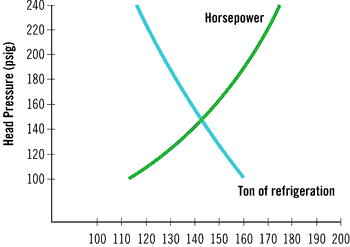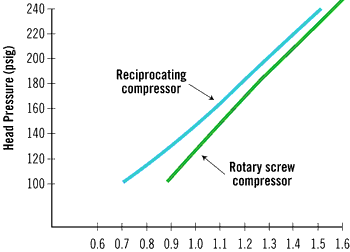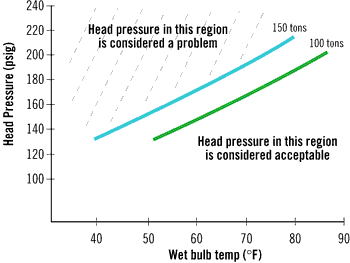

Obviously, as we increase the system head pressure, we also increase the compression ratio of the high-stage compressors. This directly translates to an increase in the amount of work the compressors must perform (i.e., greater horsepower requirements and greater energy consumption).
We will begin this discussion by examining exactly how much impact raising the system head pressure has on compressor kilowatt usage. By observing the operation of two different types of compressors — reciprocating and rotary screw — we can see the relative effect in both cases. Next, we will investigate the factors involved with system head pressure and will find that the primary component of concern is the condenser. By focusing on the requirements for efficient condenser operation, we can identify potential problems that lead to poor condenser performance.
We will limit this discussion to evaporative condensers, as they represent the majority of industrial applications to be found. Finally, condenser maintenance and upkeep concerns will be addressed, as well as the benefits of non-condensible purging.
To obtain an understanding of the effect of rising head pressure, you plot the horsepower requirements and overall capacity for a typical reciprocating compressor operating under a fixed set of conditions: suction pressure (30 psig), superheat (10°), and sub-cooling (10°). (See Figure 1.)
What we find is that if all other parameters are held constant, then rising head pressure requires more horsepower to drive the compressor. Also, we find that the compressor’s capacity drops as head pressure rises. This is shown by plotting the horsepower required per ton of refrigeration capacity vs. head pressure, as seen in Figure 2. Although the graphs shown are for a specific compressor operating under set conditions, the general form of the curves will remain consistent for any reciprocating compressor.

Compressor Types
When discussing the benefits of lowering head pressure, it is important to distinguish the differences between compressor types. Without going into detail, the reciprocating compressor will discharge gas compressed in its cylinders when the internal cylinder pressure becomes greater than the combined external pressure (head pressure) and the valve spring pressure. Therefore, lowering the head pressure directly and immediately results in lowering the compression ratio of the reciprocating compressor.In contrast, the vast majority of screw compressors in service today are fixed volume ratio machines. This means that when operating at a set suction pressure, the discharge pressure of the compressed gas leaving the screw is fixed and is independent of condensing pressure. The terms “over-compression” and “under-compression” are used to describe conditions when the compressor’s discharge pressure does not match the systems condensing pressure. If a screw compressor’s volume ratio results in over-compression, then lowering the head pressure will not produce the pronounced energy savings that would be achieved on a system with a reciprocating compressor (Figure 2). One needs to take a close look at each installation to determine the potential benefits that could be gained by lowering head pressure.
The cost of operating your system at an elevated head pressure is, of course, dependent on the kilowatt-hour rate charged by your local utility and involves a relative cost comparison when operating a system year round at various head pressures above the optimum design. (See Table 1, which accounts only for increased compressor horsepower and assumes an electric motor efficiency of 92%.) The operating conditions are as stated in the above paragraph. Generally, you can expect approximately a 1% increase in kWh per ton of refrigeration for every 2-psi rise in head pressure above optimum.
Clearly, a system designed to operate at the lowest possible head pressure will be the most efficient. Keep in mind, however, that a system which employs thermostatic expansion valves must maintain enough differential pressure (between condensing and evaporator pressures) to feed these valves adequately. As the differential pressure across the valve drops, so does the valve’s capacity. Systems which employ hot gas defrost must also have a means of elevating head pressure at the defrost cycle so as to quickly clear the evaporator of frost.
There are also practical limits to the size of condenser installations. Under no circumstances can condensing temperature in the evaporative condenser be pushed below the ambient wetbulb temperature. An approach of 6° is considered to be the limit. As the amount of condenser surface is increased to lower head pressure, the condenser’s fan and pump horsepower requirements go up accordingly. A careful designer will balance the condenser’s size for the lowest energy consumption and weigh the future returns from the energy savings against the initial capital cost.
A careful designer will also ensure that the proper pipe size is used for the compressor discharge lines. Any frictional line losses in the discharge lines will contribute to the head pressure seen by the compressor. To offset this increase, we would need to oversize the condenser. Good engineering practice would allow for 1° condenser penalty for every 100 feet of equivalent discharge pipe. This is approximately 3 psi in-line losses per 100 feet.
Special consideration must also be given to the liquid drain line from the condenser to the receiver. This line must be free draining and sized for a liquid velocity of 100 fpm or less. This low velocity allows the drain to act as a “sewer” line that permits gas to equalize back to the condenser. Multiple condenser installations must have liquid traps in the drain line of each condenser coil. The vertical liquid columns upstream of these traps act to offset any variations in the outlet pressure from coil to coil. Without the traps and pipe columns, liquid refrigerant would back up into the coil with the highest pressure drop. This would reduce that coil’s capacity and elevate the system’s head pressure. The height of the vertical column must be such that it will accommodate a liquid head equal to the maximum pressure drop that can be expected from the coil. Typically this is 5 feet for ammonia installations and 12 feet for halocarbon refrigerants. Trapped liquid drain lines are normally sized for liquid velocities of 150 fpm.

System in Service
After the system is in service, it becomes just as important to maintain your head pressure at the lowest possible levels given the equipment you have. Some operators often only concern themselves when head pressure rises above some arbitrary level. However, the actual situation is much more involved than a quick look at a pressure gauge would indicate.One needs to realize the effects of ambient wetbulb temperature on condenser performance and the effects of overall system load. A more accurate picture of head pressure levels can be visualized by charting the relationship between outdoor wetbulb temperature and the degree of system loading (Figure 3). Then we can predict what the system head pressure should be more accurately. Using this information, an operator can become aware of potential problems more quickly and thereby increase energy savings.
As usual, not enough can be said for a regular maintenance program. This is especially true when applied to evaporative condensers. First, it is imperative to ensure the water recirculation system is functioning properly. This includes cleaning the pump suction strainer, flushing the reservoir pan (or sump tank), and checking for proper spray pattern from the water nozzles. Second, the forced-air system and fans must be checked and serviced regularly. This includes lubrication of fan shaft bearings and motor bearings. Fan drives (belts) should be checked for proper tension.
Finally, the refrigerant coil inside the condenser must be cared for. As its name implies, the evaporative condenser utilizes the evaporation of water to remove heat from the refrigerant coil. As this water evaporates, it leaves behind all of its minerals and impurities. These impurities can lead to either scale buildup or corrosive deterioration of the coil. If this is not kept in check, the efficiency of the coil can be severely impaired. As a rule of thumb, every 1¼ in. of scale buildup on the coil will reduce the condenser capacity by 30%. In some cases, the water bleed-off (from the pump discharge to a drain) will be sufficient to prevent scaling. However, to keep this bleed-off at a minimum, water treatment should be implemented. The best recommendation is to contact a local water treatment specialist who is familiar with the water conditions in your location.

Non-Condensible Gases
No discussion of condenser maintenance would be complete without considering the issue of non-condensible gases (air, nitrogen, hydrogen, etc.). These gases will leak into low temperature systems whose suction pressures are below atmospheric. This occurs at valve packings, gasketed joints, shaft seals, etc. Non-condensible gases also enter a system through repairs, refrigerant charging, and by the chemical breakdown of refrigerant and oil.Since the condenser outlet is piped to a liquid trap, the non-condensible gases eventually move through the system to be collected in the condenser. Once there, the partial pressures of these gases are additives to the partial pressure of the refrigerant gas. The net effect is to raise the head pressure. The amount of non-condensible gas in the system necessary to raise head pressure is dependent on condenser volume. A previously performed case study of an ammonia system operating at 154 psig condensing/20 psig suction and containing 2% non-condensible gas experienced a 3 psi rise in head pressure. The energy penalty is this scenario would be about 1.7% per ton of refrigeration.
Traditionally, non-condensible gases were removed from the system by manual purges at the condenser. This would occur when the operator felt that the head pressure had risen to an unacceptable level. Larger plants would implement a regular schedule of condenser purges.
While manual purging is still used today, it has mostly been replaced by auto purging. The benefits of an auto-purger are threefold (Figure 4). First, it removes non-condensible gases from the system with a minimum loss of refrigerant. Second, by operating unattended on a regular schedule it is more effective at keeping head pressure at the lowest possible level at all times. Third, it is inherently safer and removes the need for an operator to allot service time for manual purges.
The operation of an auto purger is often overly complicated. All auto purgers work on the principle that, by definition, non-condensible gases do not condense. If we take high-pressure gas from the condenser and cool it, then the refrigerant vapor will condense out, leaving a gas mixture, which is primarily composed of non-condensible gases. The lower the temperature of the gas mixture, the higher the concentration of non-condensible gases. The auto-purger can now remove this mixture with a minimum of refrigerant loss from the system.
High-pressure gas to the purger should be taken from the condenser drain line. For installations with multiple purge points, a solenoid valve should be placed in each line.
The purge controller will sequence through the solenoids so as to allow each condenser to be separately purged. Under no circumstances should two purge points be opened simultaneously. This would equalize the condenser liquid drain traps and possibly cause liquid to back up into the condenser.
LeVangie is with Parker Hannifin Corp., Refrigerating Specialties Division, 2445 S. 25th Ave., Broadview, IL 60155.
Publication date: 01/08/2001

Report Abusive Comment